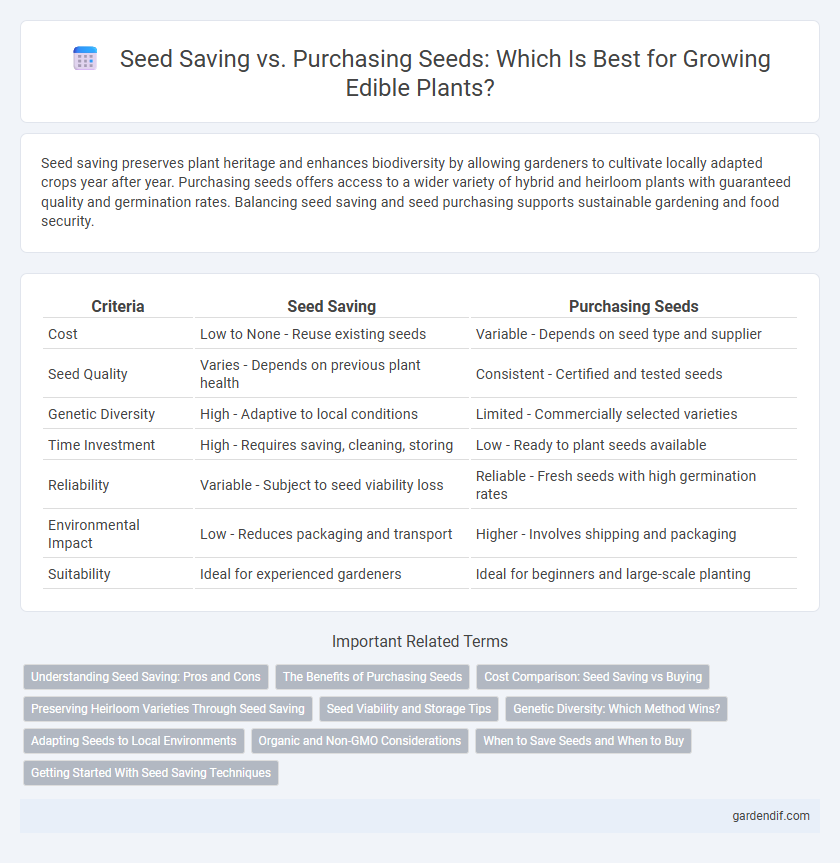
Seed Saving vs Purchasing Seeds Illustration
Seed saving preserves plant heritage and enhances biodiversity by allowing gardeners to cultivate locally adapted crops year after year. Purchasing seeds offers access to a wider variety of hybrid and heirloom plants with guaranteed quality and germination rates. Balancing seed saving and seed purchasing supports sustainable gardening and food security.
Table of Comparison
| Criteria | Seed Saving | Purchasing Seeds |
|---|---|---|
| Cost | Low to None - Reuse existing seeds | Variable - Depends on seed type and supplier |
| Seed Quality | Varies - Depends on previous plant health | Consistent - Certified and tested seeds |
| Genetic Diversity | High - Adaptive to local conditions | Limited - Commercially selected varieties |
| Time Investment | High - Requires saving, cleaning, storing | Low - Ready to plant seeds available |
| Reliability | Variable - Subject to seed viability loss | Reliable - Fresh seeds with high germination rates |
| Environmental Impact | Low - Reduces packaging and transport | Higher - Involves shipping and packaging |
| Suitability | Ideal for experienced gardeners | Ideal for beginners and large-scale planting |
Understanding Seed Saving: Pros and Cons
Seed saving preserves heirloom varieties, promotes biodiversity, and reduces reliance on commercial seed suppliers while maintaining plant traits adapted to local conditions. Challenges include the risk of cross-pollination, potential decrease in seed viability over successive generations, and the need for proper knowledge to prevent disease transmission. Balancing saved seeds with occasional purchases ensures genetic diversity and crop resilience in edible gardening.
The Benefits of Purchasing Seeds
Purchasing seeds offers access to a wide variety of high-quality, disease-resistant, and genetically stable seed options that are often tested for optimal germination rates. Commercial seed suppliers provide consistent and reliable seeds tailored to specific climates and growing conditions, ensuring better crop performance. This approach reduces the risk of planting inferior or incompatible seeds, saving time and resources for edible gardeners and farmers.
Cost Comparison: Seed Saving vs Buying
Seed saving significantly reduces costs by eliminating the need for purchasing new seeds each planting season, making it a sustainable choice for gardeners. Buying seeds often involves recurring expenses that accumulate yearly, whereas seed saving requires an initial investment in quality seeds but yields long-term financial savings. Over time, saving seeds enhances budget efficiency by promoting self-sufficiency and minimizing dependency on commercial seed sources.
Preserving Heirloom Varieties Through Seed Saving
Seed saving plays a critical role in preserving heirloom varieties by maintaining the genetic diversity that commercial seeds often lack. Unlike purchasing seeds, which can lead to genetic uniformity and loss of unique traits, saving seeds from heirloom plants ensures the continued propagation of historically significant and regionally adapted varieties. This practice supports agricultural biodiversity, empowers gardeners with self-reliance, and protects seed heritage for future generations.
Seed Viability and Storage Tips
Seed viability significantly impacts successful crop growth, with saved seeds often retaining strong germination when stored under optimal conditions, such as cool, dry, and dark environments. Proper seed storage involves using airtight containers with desiccants to maintain low humidity and prevent mold or pests, thereby extending the shelf life of seeds up to several years depending on the species. Purchasing seeds ensures genetic diversity and disease resistance but may involve variability in freshness, making knowledge of seed viability and storage crucial for both methods.
Genetic Diversity: Which Method Wins?
Seed saving preserves heirloom and open-pollinated varieties, maintaining genetic diversity critical for crop resilience and adaptation. Purchasing seeds often favors hybrids with uniform traits, potentially narrowing genetic pools and reducing biodiversity. Prioritizing seed saving supports sustainable agriculture by enhancing the genetic richness essential for future food security.
Adapting Seeds to Local Environments
Saving seeds allows gardeners to cultivate plant varieties that are naturally adapted to their specific local climate, soil, and pest conditions, enhancing crop resilience and yield over time. In contrast, purchasing seeds often introduces standardized varieties that may not perform optimally in unique environments, requiring more inputs such as water, fertilizers, and pesticides. Seed saving supports biodiversity and empowers farmers to develop seeds with traits tailored to local challenges, improving sustainability and food security.
Organic and Non-GMO Considerations
Saving seeds from organic, non-GMO plants ensures preservation of genetic diversity and adaptation to local growing conditions, promoting sustainable agriculture. Purchasing organic, non-GMO seeds guarantees certified purity, reducing exposure to genetically modified traits and synthetic chemicals. Both practices support environmentally friendly gardening, but seed saving demands careful selection to maintain organic integrity and avoid cross-contamination.
When to Save Seeds and When to Buy
Saving seeds is ideal for heirloom and open-pollinated plants, allowing gardeners to preserve specific traits and reduce costs in subsequent growing seasons. Purchasing seeds is recommended for hybrid varieties or when disease resistance and high germination rates are priorities, ensuring consistent plant performance. Timing seed saving depends on allowing plants to fully mature and produce viable seeds, typically at the end of the growing season, while buying seeds is best done before planting to secure desired varieties.
Getting Started With Seed Saving Techniques
Starting seed saving involves selecting healthy, open-pollinated plants to ensure genetic purity and viability for future planting. Techniques such as drying seeds thoroughly and storing them in cool, dark, and airtight containers extend their lifespan and germination rates. Mastering seed saving reduces dependency on purchasing seeds, lowers costs, and promotes sustainable gardening practices.
Seed Saving vs Purchasing Seeds Infographic

 gardendif.com
gardendif.com